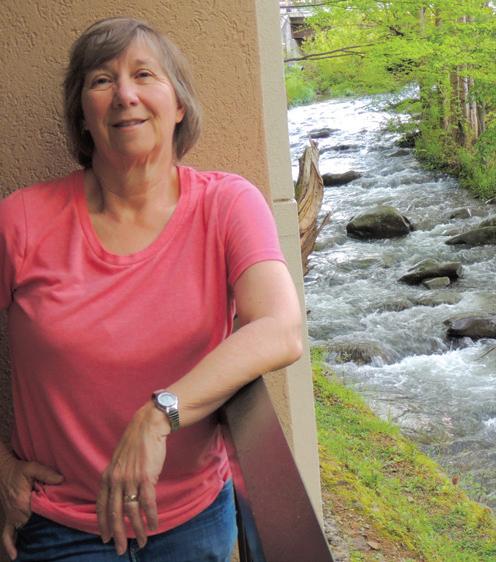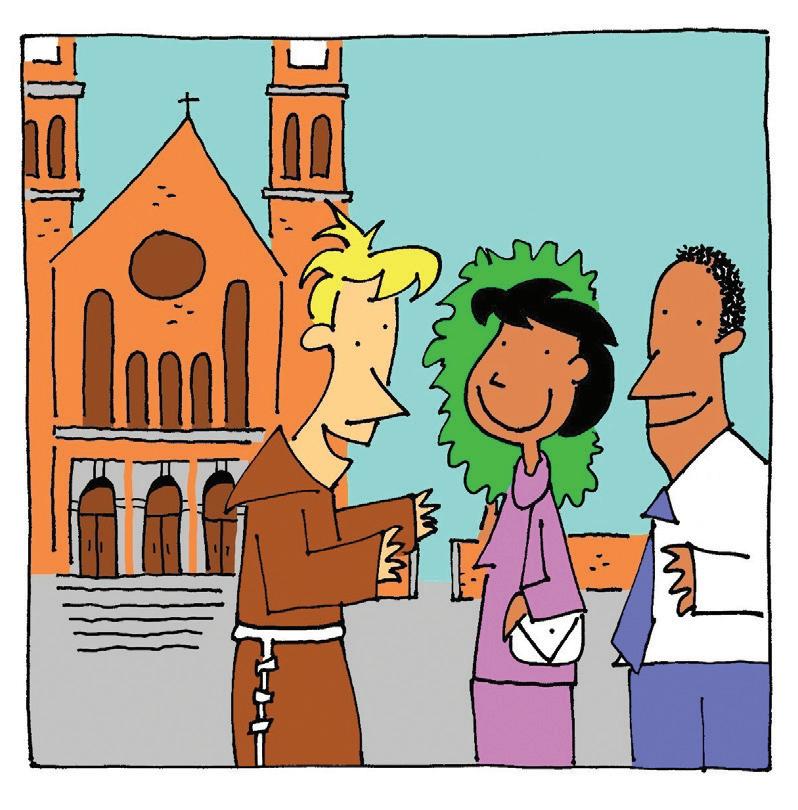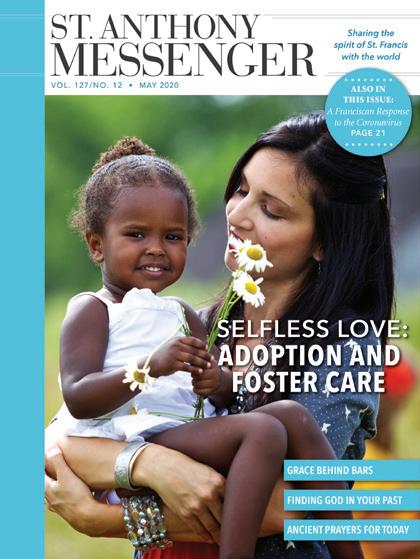
13 minute read
Faith & Family | Susan Hines-Brigger
Susan Hines-Brigger
Susan has worked at St. Anthony Messenger for 27 years and is an executive editor. She and her husband, Mark, are the proud parents of four kids— Maddie, Alex, Riley, and Kacey. Aside from her family, her loves are Disney, traveling, and sports.
Advertisement
Susan welcomes your comments and suggestions!
E-MAIL:
CatholicFamily@ FranciscanMedia.org
MAIL:
Faith and Family 28 W. Liberty St. Cincinnati, OH 45202
WANT MORE? VISIT: FranciscanMedia.org/ faith-and-family
The Day My Daughter Left the Church
“I know I’m somebody because God doesn’t make junk!”
When our children were younger and my husband, Mark, and I used to teach religious education classes, we would always seem to come across this phrase in the resources at our disposal. Often we would find it on coloring pages that were used to occupy the kids when they first came into class. The pictures would change but the message was always the same: No matter what, you are a beloved child of God—because God doesn’t make junk.
As my kids have grown, I’ve returned to this phrase time and time again—in more grown-up wording, of course—as they’ve encountered issues that challenge their selfconfidence or make them doubt their own self-worth. We’ve also used it to teach them that everyone, everyone, is created as a child of God and, therefore, perfect.
HURTFUL WORDS OF EXCLUSION
That phrase sprung from the recesses of my mind on the day when I saw my oldest daughter, Maddie, walk away from the Church six years ago. It was an ordinary Sunday with our family gathered together for weekly Mass, as we always did. We were your typical Catholic family—often late for Mass and doing the best we could to raise our children in the faith that Mark and I hold dear. All of our kids have gone to Catholic grade school and high school.
When the priest began to preach the homily, for some reason I started to get a disheartening sense that it was not going to be an uplifting one. There was nothing about that week’s readings. Instead, the topic was plucked straight out of the headlines. That day’s homily was about the Supreme Court’s ruling on same-sex marriage. The tone was not loving. In fact, it was very much the opposite.
As the homily continued, the words began to extend beyond the ruling and, whether intentionally or not, poured over into a commentary on homosexuality in general. I remember turning and seeing the look on Maddie’s face. She has friends who are members of the LGBTQ community, and I knew the words were piercing her heart. I watched her drop her head, and the protective mom in me started to rise to the surface. How dare this priest? I thought. How dare he talk about these amazing, wonderful kids like that? He doesn’t know them.
After we left Mass, Maddie told me she wasn’t going back. As much as it hurt to hear it, I can’t say I didn’t understand. All of the teaching we had done over the years about unconditional love for everyone was undone in the span of five minutes.
Now, you may say that her reaction was hasty and that Mark and I were not proactive enough in stopping her from walking away. You’re entitled to your opinion. I happen to disagree. What she heard that day did not represent the welcoming, all-loving faith that we had raised her in.
Quite honestly, it took me a while to go back myself. What if that was one of my kids he was talking about? I heard similar reactions from some of the other parents in the parish.
A LASTING PAIN
Six years later, Maddie still has not returned to the Church. I have told her that it was only one priest who uttered those hurtful and exclusionary words. I pointed out that the things that priest said stood in direct contrast to the Church’s teaching on the treatment of the LGBTQ community. Many in the Church, such as Father James Martin, SJ, and Pope Francis, have advocated for members of the community, I told her.
But she isn’t buying it. She has seen the way in which her friends are still regarded by many in the Church. Those voices are the ones that seem to stick. Why, she asks, would my friends want to be somewhere they are not sure they’re wanted, just because of who they are? Why would I contribute to that hurt, she asks.
And Maddie’s not alone. For too many, the Church is not doing enough to assure our LGBTQ brothers and sisters that they are very much a part of our Catholic community, and that we fully believe they are beautiful and perfectly created children of God.
Iwish you could meet my family. Our children—and their spouses and children—enrich my life and my husband’s life in countless ways.
We have five children, three of them married, and two young grandchildren. Of the eight adults, caring professions are the norm: a social worker, an adolescent psychologist, a children’s librarian, an essential medical worker, an educator. Others work in analytics, marketing, and sales.
They are all good-hearted, generous people. Some of them are artistic and creative. Some are analytical. Some are outgoing, others introspective. Some volunteer to make Christmas possible for hundreds of children every year. Others volunteer at women’s service agencies. They are fierce proponents of justice and human rights. All have welcomed rescue dogs as forever members of their families. Some are conservative, while others land on the liberal side. All of them are the kind of smart, thoughtful, loving people anyone would be proud to call their children.
And don’t get me started on the grandkids! They’re the smartest, cutest, most clever kids you ever saw. That’s my story, and I’m sticking to it.
I love them all fiercely, proudly, and unconditionally.
In many ways, we’re like every other family out there. We’re certainly not perfect. We fight, reconcile, and grow stronger in our family bonds. We’ve held together through highs and lows, through marriages and divorces, deaths and new lives. We celebrate the good times and mourn the bad. We love each other.
We’re probably very much like your own family.
Sandy Howison
I wish you could meet my family. The people I just introduced are bisexual, gay, straight, and transgender. Single, married, divorced, remarried. Stepfamilies. A surrogate to a same-sex couple.
Would you still like to meet my family?
Did the doors of your mind slam shut after you read that paragraph? I hope not, because my children and their spouses are the same people I described at the start of this article. They’re still smart, caring, wonderful people. Did you picture them as the Catholic Church says they should be, or as they really are?
The Catechism of the Catholic Church calls some of my children “intrinsically and objectively disordered.” But I doubt God sees them that way. The Bible says we’re all made in God’s image and likeness. Years ago, bumper stickers proclaimed that “God doesn’t make junk.” My family members are not junk. They have a right to be the people they were born to be.
The Church’s behavior on the subject of sexual ethics is muddled, to say the least. Repeated actions and revelations about clergy sex abuse—as well as the cover-ups from the higher-ups—have tarnished Catholic leaders’ reputation and severely compromised their credibility. I wish Church leaders would look at my family members through God’s eyes and see the beautiful souls within. I wish they would recognize their beautiful physical selves as well.
But you—the reader—what do you think?
I wish you could meet my family.
Would you welcome them? Or would you turn away? —Sandy Howison


Friar Pete Meet
These scenes may seem alike to you, but there are changes in the two. So look and see if you can name eight ways in which they’re not the same. (Answers below)
Carol Ann Morrow
Carol Ann Morrow is an associate of the Sisters of St. Francis, Oldenburg, Indiana. She is also a wife, sometimes a mother to two grown stepchildren, and always a grandmother of four. She was on the staff of St. Anthony Messenger for 25 years and is the author of A Retreat with Saint Anthony: Finding Our Way (Franciscan Media).
WANT MORE? Check out our daily online prayer resource, Pause+Pray: FranciscanMedia.org/ pausepray
St. Clare’s Prayerful Life

I’ve never been a fan of religious icons, I blush to tell you. Their typical flat formality must please admirers of the prayerful art form, but their subjects are seldom depicted with smiles on their faces.
Recently I discovered an icon I can appreciate. In the image, created by Franciscan Brother Robert Lentz, St. Clare of Assisi cradles a cat in her arms! Neither Clare nor the monastery’s cat is smiling broadly, but no one feeling the vibration of a robust purr can keep from smiling for long!
This is a Clare I can embrace. I want to honor her guidance in my prayer life. This is the saint who is followed with great joy by women in monasteries. No one ever suspected I was called to an enclosed life. If you are, bless you. But all of us can find in Clare some markers on the path to communion with the divine.
Biographers describe the youthful Clare as beautiful. The Clare who spent decades bedfast yet bold in leadership, gentle in guidance, and stubborn in poverty, is less physically attractive but more courageous and inspiring. Two episodes from her life—one small and private, one big and brave—exemplify her confidence in divine guidance.
LET YOUR JAR GO EMPTY
Francis and his brothers begged on behalf of the sisters. In a tale reminiscent of Elijah and the widow (1 Kgs 17:8–16), the women ran out of oil. Clare washed a jug and left it out for one of the brothers to use in begging for more. When the brother came, he found the jug was already full.
In this early story, I have found a parable of the poverty to which Clare was dedicated. The emptiness which the sisters promised is my need also. Clare knew that with spiritual clarity. Some days I share that vision. More often, however, my jar requires extensive scrubbing, rinsing, and reexamination before anyone—however divine—could bear to share the “oil of gladness” with me. It takes freedom from desire and freedom from fear to place the jar out to receive what I need. Many times, I don’t even know what I need. Probably not oil. I am more in need of emptiness. Clare has given me a concrete example of what that could bring me.
FREEDOM FROM THINGS
If Pope Francis gave me an order, I’m pretty sure I would bend. Four popes told Clare that the sisters needed financial security. They
counseled her against the “privilege of poverty,” even discouraging the friars from caring for the sisters. Perhaps they wanted to scare them. But Clare was adamant. She persevered through her long illness until she was assured of her claim to nothing. Then she died.
It’s possible to have things and yet be free from them. It’s also possible to give things away but long to have them back. More than 50 years ago, I gave my best doll to the Red Cross, dressed in her green velvet coat. I would welcome an assurance that some other girl loves her as much as I did. That’s not the idea.
If I’m to be truly prayerful, I must let go of not only my doll, but also Mom’s china, a bulging collection of bath towels (in search of the perfect hue), and my dream of a pergola with wisteria. Clare slept on a straw mat, but she was happier than I am: less laundry, no insurance bills, plus a cat. I find it a different emptiness than the jar for oil—my inner self.
The privilege of poverty, as much as I can embrace it, is an outer simplification. Advancing age reveals it to me, but Clare shows me how to maximize its revelations. St. Clare wrote four letters to St. Agnes of Bohemia. While medieval in style, they offer insight into Clare’s own prayer.
MIRRORED IN THE MONASTERIES
Back in the ’80s, I stayed one Saturday night at a Poor Clare monastery in the Bronx. The neighborhood seemed downtrodden. The Poor Clares were bright lights in brown habits. While I worshipped in the body of the church, the sisters attended Laetare Sunday Mass behind a curtained grille.
While we ate breakfast, I found all the sisters in shades of Laetare pink— scavenged from castoffs donated for the neighbors all around. It was theirs only for the day. Some outfits were amusing, others classy, and some looked suspiciously like bathrobes. Clare had taught them well.
When I visited the monastery at San Damiano, I saw two small bouquets of wildflowers: one at Clare’s place in the dining hall, the other at the site of her pallet. She seemed so real there, more than any icon could reveal. Happy women had picked and placed those flowers. A happy woman had fought for the privilege.
To become more prayerful, start to smile at the ways you are rich and smile at the ways you are poor. That smile might break into laughter. That’s what happens to the followers of Clare.
PRAYER OF ST. CLARE
With swift pace, light step,
[and] unswerving feet,
so that even your steps stir up no dust,
go forward,
securely, joyfully, and swiftly,
on the path of prudent happiness.
—Second Letter to St. Agnes
PRAYERFUL TIPS IN THE SPIRIT OF ST. CLARE
1Give something you love away. Pray to let go both before and after.
2Place an empty jar that once held oil where it will call you to be open and empty.
3Poor Clares often offer spiritual direction and guidance. Search for a monastery in your area—or see if virtual visits are possible.


Whenever we look to Mary, we come to believe once again in the revolutionary nature of love and tenderness. In her we see that humility and tenderness are not virtues of the weak but of the strong.

—Pope Francis


THANKS FOR MAKING US AN AWARD-WINNING MAGAZINE!
FIRST PLACE

Best Interview: I Was a Stranger and You Welcomed Me (February 2020)

The Catholic Media Association (CMA), established in 1911, is an association of publishers and communicators. Every year, the CMA holds an awards program to honor published works that inform and promote the mission of the Church. February 2020 May 2020 Best Reporting of Social Justice Issues – Life and Dignity of the Human Person:
Keeping Hope Alive on Death Row (May 2020)
January 2020 June/July 2020 August 2020 October 2020 December 2020/January 2021
Second Place Best Essay: A Fresh Perspective on Being Pro-Life (January 2020)
Best Feature Article: Confronting Teen Suicide (June/July 2020)
Third Place Best Editorial: Standing in Solidarity against Systemic Racism (August 2020)
Best Illustration: e Courage to Change: Wisdom from Assisi (August 2020)
Best Feature Article: Health-Care Heroes: New York City Nurses (December/January 2021)
BOOK AWARD
Honorable Mention Best Reporting of Social Justice Issues – Life and Dignity of the Human Person: Kayla McKeon: Trailblazer, Advocate (January 2020)
Best Photo Story – Feature: Faith in Focus: Images of God’s Creation (October 2020)
Best Website – General Publisher: Franciscan Media, FranciscanMedia.org
Second Place:
Books About Prayer: Soul Training with the Peace Prayer of Saint Francis, by Albert Haase, OFM










